Comments?
For the basics, see
- Website & Privacy Policies
- How To Get Involved
- The Role of the Park
Search options:
Department Site Map
Custodians:
posted July 14, 2006
DUFFERIN GROVE PARK, TORONTO 2006 cob in the park
Earthen Sculpture and Waste Management Project Summer 2006
Quick Page Table of Contents
Scanning...
What’s going on?
This project would engage the Dufferin Grove Park community in a unique and exciting art project this summer. A composting toilet unit would be installed in the south end of the park, near to the playground and wading pool, and would be enclosed and protected by a small earthen building. As was the case last year, park attendees would be invited to participate in the making of the building.
Why do we need it?

Foundation in Autumn 2006
Toilet facilities: The south end of the park is home to a children’s playground, a wading pool, an adventure playground for older kids, a volleyball court, and an outdoor kitchen/summer café. With the height traffic in this area from spring through fall, it is the perfect spot to provide additional toilet facilities in the park.
Learning opportunities: The toilet would function as a site to learn about environmentally-friendly waste management alternatives. And like last year’s creation, this project will invite neighbours and friends of the park to become directly involved in the construction, and to learn about natural building techniques.
Resource management: This building method takes materials out of the waste stream and uses them to create structures. Examples include clay subsoil, surplus straw from farming, and concrete chunks from ripped-up sidewalks.
Community-building: Building the cob courtyard last year opened many people’s eyes to the power of working together and of using their own labour to create something beautiful. Many are anxious to have another opportunity and this project will allow them to do so.
Why a composting toilet?
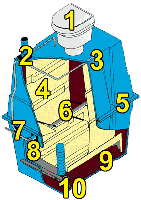
When developing the idea for the cob wall last year, Georgie talked with city offi cials about the possibility of including a fl ush toilet facility in her plans. Because of the structure of the plumbing in the south end of the park, the city deemed toilet plumbing hook-up to be too expensive for the city to consider. As an alternative to a fl ush toilet, the Phoenix composting toilet is a completely self-contained system that does not require sewer or plumbing hook-up.
How does it work?
The system takes the form of a large blue bin with two sets of rotating tines inside it, and interior baffl es to separate liquids from solids. Before its fi rst use, the bin is fi lled two thirds full with wood shavings, which act as a bulking agent and help the waste to compost properly. As the waste moves through the shavings, it is slowly digested, ending up as compost in the bottom of the bin. Usually the first batch of compost is ready two years into the toilet’s use.
Does it smell?
As the material is integrated into the wood shavings, it loses its objectionable smell. The Phoenix composting toilet also has a robust fan inside the bin that draws air into the bin through the toilet seat and out through a venting stack. This results in slight negative pressure inside the washroom, keeping any smells from leaking into it.
How much use can it take?
In the summer, this facility is rated at approximately 100 uses per day. The manufacturer allows increases to this number for seasonal operations and for daytime usage operations (day time usage involves mostly liquids as opposed to solids).
An automatic counter will be installed on the door so that staff have some idea how much use the toilet is getting. If they have concerns about overuse, they will simply close and lock the facility until the toilet has had a chance to rest.
Are there any other emissions?
Since a vast majority of the input is liquid, most of what goes in ends up evaporating. The remainder of the liquid is pumped back over the bulking material to keep it moist and actively composting. In the case of excess liquid, the system is set up to output to a leaching bed. This is an ornamental garden with a tube running under the soil where the leachate is pumped out to. There it disburses high above the water table and the nutrients from it are allowed to back into the soil.
From the Phoenix Facility Application Guide:
The liquid end product contains considerable bacteria and dissolved salts, but generally has a low coliform indicator concentration (<200 org/100 ml), low BOD, (<50mg/liter) and low TSS (<100 mg/liter) compared to septic tank effl uent, so a short (10-foot; 3-meter) leach line is all that is necessary.
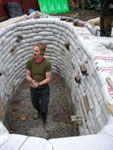
Who will maintain it?
To keep the toilet composting properly, the toilet needs about five minutes of maintenance a day, which park staff will attend to. Keeping the room clean will be a joint effort between users and staff. Any abuse of the facility may result in its temporary closing to maintain its safety.
When would it happen?
Once final permission is received, work will begin immediately, so that it might be possible to have the toilet operational before the end of the summer.
Where would it go?
There are several sites being considered, pending community input, city approval and site suitability:
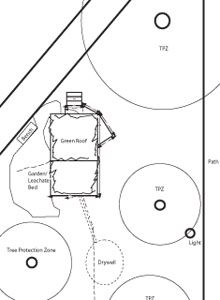
1) South of the wading pool, near to the new trees that were planted there this spring
Advantages: Accessible to the people most likely to use it
Disadvantages: Proximity to housing south of it
2 & 3) West and south of the cob wall
Advantages: Will beclose to the other structure, providing thematic continuity and less visual intrusion for the rest of the park
Disadvantages: Not as easy for staff to monitor visually Users will have a more difficult time watching their playing children while attending to their washroom-using children
May not be allowed due to underground lines and drainage
4) Across the path, by the electrical panel
Advantages: Out of the way of the other happenings in the park
Close to electrical hook-up
Disadvantage: Not as close to the playground as others, and so is less useful to park attendees, especially those trying to look after several children
What would it look like?

There are building considerations that will determine in part what the building will look like. For example, the bin is quite tall, so the building will likely be tall, and have stairs and/or a ramp for access. It will likely have a green roof. The footprint of the building will probably be an oval shape. Several building techniques might be employed including cob, straw/clay slip, or wattle and daub, among others. Windows will be large enough to let in light and air, but small enough to prevent the passage of people. The walls will be plastered and will feature sculptures in bass relief. As with the cob wall, participants will help to make day-to-day decisions on certain aspects of the design as they are working, and will therefore contribute to the eventual appearance of the building.
Where can I find out more?
You can peruse the Phoenix Facility Application Guide (copies in the newsletter box), or go to www.compostingtoilet.com and click on Public Facilities Application Guide. Also see the accompanying poster for information on the public meeting scheduled to be held in this park.
Very Small Buildings | |
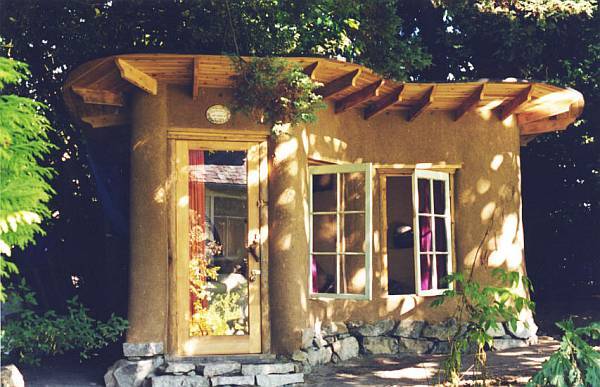 | |
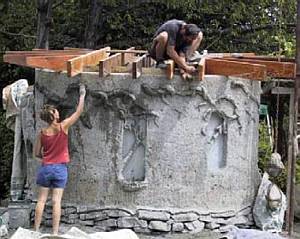 |
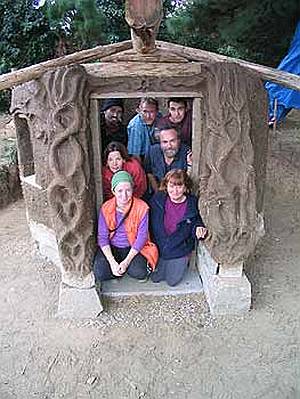 |
1: www.alternatives.com/cob-building/vancouver.html
2, 3: www.earthedworld.co.uk




 Printer friendly version
Printer friendly version